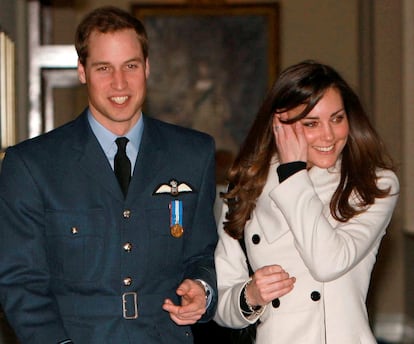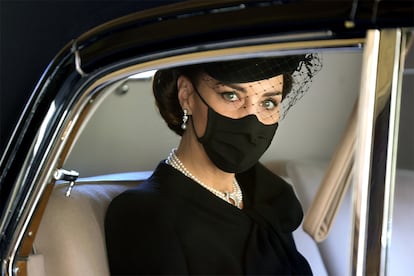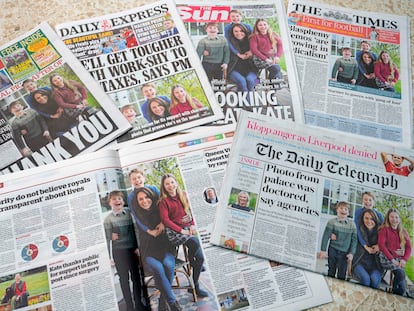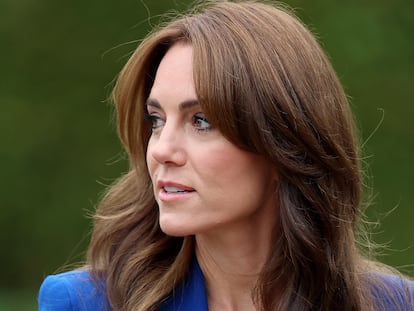Kate Middleton, the woman who rose to the top and conquered the British people
The Princess of Wales has followed in the footsteps of Elizabeth II by portraying a traditional image and a sense of duty at her public events
Kate Middleton, 42, had to grace thousands of covers and front pages until she reached a place where it was not criticism that could be heard, but the admiration of the public. When she revealed that she is undergoing preventive chemotherapy to stop the cancer she is suffering from, the shock was not her own, but that of all the media and anonymous — and not so anonymous — people on social media who had been making jokes about her health for two months.
Before she became known to half the world, first as the Duchess of Cambridge, then Princess of Wales, and always as the wife of the heir to the throne, William, Prince of Wales, she succeeded in climbing Mont Blanc, the highest peak in the Alps and the highest in Western Europe, with her father, Michael Middleton. She came from a very athletic family, who did not shy away from challenges.
“Over the years, we have climbed many mountains together. As a family, we will climb this one with you too,” Middleton’s brother, James William Middleton, wrote on Friday on his Instagram account, alongside an old photo of the two, showing them as two smiling children still in the midst of nature.
No sooner had her courtship with Charles and Diana’s eldest son come to light than the British tabloid press accused Kate of being a social climber. She and her sister, Pippa, were referred to as the “Wisteria sisters,” with the sexist overtones that continue to mark U.K. tabloids today. This was in reference to Wisteria, a plant that is popular on the facades of London residences: it is beautiful and decorative, has an intense fragrance and climbs quickly, the joke goes.

Then there was also the nickname “Waity Katie,” to taunt the young woman who waited desperately for Prince William to decide to propose to her. They referred to her as a “commoner,” and called into question her jitters in public, her shrill voice and her dull attire. After the years in which Lady Di was the model, such a conservative, conventional and nondescript character was unpopular. Despite these characteristics being precisely the ones that were most admired in the late Elizabeth II.
Years of revival
Even the series The Crown (Netflix) latched onto the theory that Carole Middleton had painstakingly sculpted her daughters’ social trajectory to the very top. She is credited with the decision to pull Kate out of Edinburgh University, when she had barely been there for a year, and send her to St. Andrews, where Prince William had just enrolled, and where their courtship eventually materialized.
On April 29, 2011, the wedding was held at Westminster Abbey. Since then, Middleton has not taken a wrong step, at least in the view of that part of the conservative and traditional British society that desires a monarchy with all its conventions. She is a dedicated mother — the couple has three children: George, Charlotte and Louis —, and supports her husband unconditionally. She was devoted to Elizabeth II and now follows her father-in-law, King Charles III. When she appears at public events, she shows polished correctness. In other words, she has all the attributes required of a future queen.

Some critics saw more calculation than naturalness in her behavior. Hilary Mantel, the writer idolized by many Britons for her trilogy on the Tudors, defined Kate as “precision-made” with no apparent flaws, “so different from Diana, whose human awkwardness and emotional incontinence showed in her every gesture.” However, those who keenly followed the ins and outs of the British royal family, or those who simply want as little extravagance as possible from their institutions, grew to love a woman who carried out the duties of her office rigorously and in good spirits. The Windsors have always known that a smile is a much more effective communication weapon than any public statement, and Kate has never stopped smiling.
When she confessed to writer Giovanna Fletcher that she had felt “slightly terrifying” when introducing newborn Prince George to the media in 2013 from the hospital steps — a tradition bestowed on all the women in the royal family, which only Meghan Markle chose to break — Kate adhered to the rule that worked so well for her grandmother-in-law Elizabeth II: obligations always come before needs. “For us to be able to share that joy and appreciation with the public, I felt was really important,” Middleton explained.
In recent days, the Princess of Wales has discovered that the public is insatiable when it comes to news. It does not want just the joys, it also wants the sorrow. Despite her initial resistance, and her desire to protect the couple’s three children, Kate has chosen to reveal to the world her state of health and her own current anguish. And in doing so, she has climbed back to the peak that took her so much effort to conquer: the only place where she can feel protected.
Sign up for our weekly newsletter to get more English-language news coverage from EL PAÍS USA Edition
Tu suscripción se está usando en otro dispositivo
¿Quieres añadir otro usuario a tu suscripción?
Si continúas leyendo en este dispositivo, no se podrá leer en el otro.
FlechaTu suscripción se está usando en otro dispositivo y solo puedes acceder a EL PAÍS desde un dispositivo a la vez.
Si quieres compartir tu cuenta, cambia tu suscripción a la modalidad Premium, así podrás añadir otro usuario. Cada uno accederá con su propia cuenta de email, lo que os permitirá personalizar vuestra experiencia en EL PAÍS.
¿Tienes una suscripción de empresa? Accede aquí para contratar más cuentas.
En el caso de no saber quién está usando tu cuenta, te recomendamos cambiar tu contraseña aquí.
Si decides continuar compartiendo tu cuenta, este mensaje se mostrará en tu dispositivo y en el de la otra persona que está usando tu cuenta de forma indefinida, afectando a tu experiencia de lectura. Puedes consultar aquí los términos y condiciones de la suscripción digital.
More information
Archived In
Últimas noticias
Welcome to the post-religion era: The idea of Christianity as the absolute truth has become obsolete
‘I thought you would like it’: The risky sexual practice popularized by TV shows and TikTok
The digitalization of tourism: ‘They promise experiences and gave us the worst possible one’
Mexican peso defies uncertainty with forecasts of a new period of stability in 2026
Most viewed
- Sinaloa Cartel war is taking its toll on Los Chapitos
- Reinhard Genzel, Nobel laureate in physics: ‘One-minute videos will never give you the truth’
- Oona Chaplin: ‘I told James Cameron that I was living in a treehouse and starting a permaculture project with a friend’
- Why the price of coffee has skyrocketed: from Brazilian plantations to specialty coffee houses
- Silver prices are going crazy: This is what’s fueling the rally












































